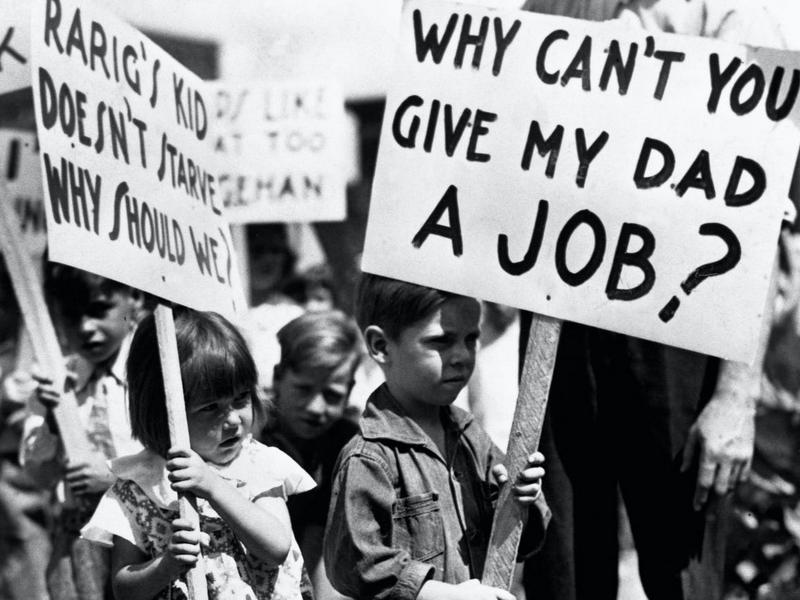January 31, 2021
This Would Be $1,443, Adjusted For 2021 Inflation, Which Shows How Desperate People Were
In the years leading up to the Stock Market Crash on October 29, 1929, life was good for most Americans. With easy access to credit and a booming economy, many people, like investor Walter Thornton, shown in this colorized photograph from the time, enjoyed unprecedented prosperity, which allowed them to enjoy the finer things in life.
It's one thing to look at this photo in black and white. Without color it's firmly based in the past, and it looks like something that we're far away from. In its colorized state, this depressing snapshot feels all too vital and contemporary. $100 may not be able to buy anyone a car these days, but the color makes this shot look tactile and all the more prescient

Thornton, and many more like him, had their world toppled when, on October 29, 1929, panicked investors traded more than 16 million shares on Wall Street’s New York Stock Exchange. Stock prices tumbled and the market crashed. Overnight, Thornton and others like him, lost everything they had. This colorized photograph tells the story of how desperate some folks were to get their hands on cash.
The Great Depression

When the Stock Market crashed, billions of dollars were lost. Businesses went bankrupt and employees lost their jobs. Unemployment rates skyrocketed. People lost their homes. The United States was plunged into the Great Depression, the worst economic downturn in history. It lasted an entire decade. The Great Depression impacted every industry in America, but none harder than the automobile industry.
The Rise and Fall of the Automobile Industry

From the turn of the 20th century, the automobile industry revolutionized American life. When Henry Ford began to roll his Model T Fords off the assembly line, the automobile became an affordable luxury for many Americans, especially for the Americans who reaped the benefit of a booming economy. With an automobile at their disposal, the world opened up. Families could go on road trips. Husbands could commute into the city for work. Rural wives were no longer confined on the farm. At the time of the Stock Market crash, there was one automobile for every six people in the U.S. (more than 5.3 million passenger cars). In a relatively short amount of time, automobile ownership modernized life in such a way that it was hard to imagine life without a car.
The Snowball Effect

The rise of the auto industry in the 1920s had a snowball effect on other industries. More oil, steel, rubber, glass, and leather were needed to support automobile manufacturing. Factory machines and tool and die equipment were also in demand. All those cars needed gas and servicing, so gas stations and service stations popped up. The governments began programs to upgrade infrastructure to accommodate the number of cars. Highways, bridges, and overpasses were built. All of this came to a screeching halt on October 29th. 1929. Most people could no longer afford to purchase cars. The snowball effect ramped up again. Auto workers lost their jobs, gas stations and service stations closed, and highway construction projects stopped.
The Need for Cash

Then the Stock Market crashed and numerous banks shut down. The banks had extended credit to so many people that they went bankrupt when customers couldn’t make good on their loans. The customers that had money in the bank when they closed lost their savings. Distrust of banks was understandably common. Like Walter Thornton in this colorized photograph, what folks needed the most was cash. Thornton’s classy, status-symbol car was no longer needed. Cash was much more important. Sadly, so few people had money to spend, especially on luxury items like Thornton’s roadster, that it doesn’t seem likely that he found a buyer for her vehicle, despite its bargain price.
The Auto Industry: Down But Not Out

The Stock Market Crash and the Great Depression hit the auto industry hard, but not enough to kill it. As the Great Depression wore on, Americans remained leery about making large purchases. Unemployment was high and job stability was worrisome. Even people who were lucky enough to have jobs, couldn’t be sure they would have them in the future. Income was down, too. On average, annual incomes were half of what they were prior to the Stock Market crash. The Great Depression hit small automakers, like Auburn-Cord-Duesenberg, Pierce-Arrow, and Franklin, couldn’t survive, but larger can manufacturers fared better. Joining the Big Three automakers -- Ford, Chrysler, and General Motors -- were car companies like Studebaker, Packard, DeSoto, and Crosley. Even though these manufacturers survived the Great Depression, only a few of these are still around today.
War as Economic Salvation

The start of World War II in 1939 brought about the end of the Great Depression and a salvation to the automobile industry. The American economy regrouped and mobilized for the war effort. Automobile factories produced cars and trucks for the military. More and more people found jobs in the car factories and other industries that supported the war effort. Even when the war ended, the auto manufacturers retooled to produce passenger cars. Thanks to the war, the economic downturn of the Great Depression was reversed. With good, steady incomes, Americans once again felt secure enough to buy family cars. Automakers that weathered the Great Depression came out on the other side to enjoy prosperity once again. When Walter Thornton was forced to sell his luxury car following the Stock Market crash of October 29, 1929, he may not have been able to envision that it would take a decade-long economic depression and a global war before financial matters in the United States improved to the point that families had the expendable income to purchase cars like his once again.
